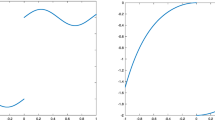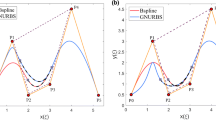Abstract
We introduce CINAPACT-splines, a class of \(C^\infty \), accurate and compactly supported splines. The integer translates of a CINAPACT-spline form a reconstruction space that can be tuned to achieve any order of accuracy. CINAPACT-splines resemble traditional B-splines in that higher orders of accuracy are achieved by successive convolutions with a B-spline of degree zero. Unlike B-splines however, the starting point for CINAPACT-splines is an infinitely smooth and compactly supported bump function that has been properly normalized so that it fulfills the partition of unity criterion. We use our construction to design two CINAPACT-splines, and explore their properties in the context of rendering volumetric data sampled on Cartesian grids. Our results show that CINAPACT-splines, while being infinitely smooth, are capable of providing similar reconstruction accuracy compared to some well-established filters of similar cost.
Access this chapter
Tax calculation will be finalised at checkout
Purchases are for personal use only
Similar content being viewed by others
References
Hossain, Z., Alim, U.R., Möller, T.: Toward high quality gradient estimation on regular lattices. IEEE Trans. Visual. Comput. Graph. 17, 426–439 (2011)
Runions, A., Samavati, F.: CINPACT-splines: a class of C-infinity curves with compact support. In: Boissonnat, J.-D., Cohen, A., Gibaru, O., Gout, C., Lyche, T., Mazure, M.-L., Schumaker, L.L. (eds.) Curves and Surfaces. LNCS, vol. 9213, pp. 384–398. Springer, Heidelberg (2015)
Runions, A., Samavati, F.F.: Partition of unity parametrics: a framework for meta-modeling. Visual Comput. 27, 495–505 (2011)
Shannon, C.E.: Communication in the presence of noise. Proc. IRE 37, 10–21 (1949)
Unser, M.: Sampling-50 years after shannon. Proc. IEEE 88, 569–587 (2000)
Nehab, D., Hoppe, H.: A fresh look at generalized sampling. Found. Trends Comput. Graph. Vis. 8, 1–84 (2014)
Strang, W., Fix, G.: An Analysis of the Finite Element Method. Prentice-Hall, Englewood Cliffs (1973). Prentice-Hall series in automatic computation
Buhmann, M.: Radial Basis Functions: Theory and Implementations. Cambridge University Press, New York (2003). Cambridge Monographs on Applied and Computational Mathematics
de Boor, C., Höllig, K., Riemenschneider, S.D.: Box splines, vol. 98. Springer, New York (1993)
Unser, M.: Splines: a perfect fit for signal and image processing. IEEE Signal Process. Mag. 16, 22–38 (1999)
Schönberg, I.J.: Contributions to the problem of approximation of equidistant data by analytic functions. Quart. Appl. Math 4, 45–99 (1946)
Blu, T., Thévenaz, P., Unser, M.: Moms: maximal-order interpolation of minimal support. IEEE Trans. Image Process. 10, 1069–1080 (2001)
Blu, T., Unser, M.: Quantitative fourier analysis of approximation techniques. i. interpolators and projectors. IEEE Trans. Signal Process. 47, 2783–2795 (1999)
Kindlmann, G., Whitaker, R., Tasdizen, T., Möller, T.: Curvature-based transfer functions for direct volume rendering: methods and applications. In: Visualization 2003, pp. 513–520. IEEE Computer Society Press (2003)
Marschner, S.R., Lobb, R.J.: An evaluation of reconstruction filters for volume rendering. In: Visualization 1994, pp. 100–107. IEEE Computer Society Press (1994)
Author information
Authors and Affiliations
Corresponding author
Editor information
Editors and Affiliations
Rights and permissions
Copyright information
© 2015 Springer International Publishing Switzerland
About this paper
Cite this paper
Akram, B., Alim, U.R., Samavati, F.F. (2015). CINAPACT-Splines: A Family of Infinitely Smooth, Accurate and Compactly Supported Splines. In: Bebis, G., et al. Advances in Visual Computing. ISVC 2015. Lecture Notes in Computer Science(), vol 9474. Springer, Cham. https://doi.org/10.1007/978-3-319-27857-5_73
Download citation
DOI: https://doi.org/10.1007/978-3-319-27857-5_73
Published:
Publisher Name: Springer, Cham
Print ISBN: 978-3-319-27856-8
Online ISBN: 978-3-319-27857-5
eBook Packages: Computer ScienceComputer Science (R0)




